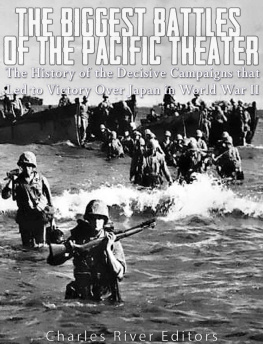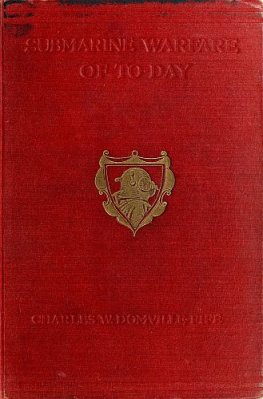Charles River Editors - Submarine Warfare in World War I: The History and Legacy of the German U-boats and Allied Efforts to Counter Them
Here you can read online Charles River Editors - Submarine Warfare in World War I: The History and Legacy of the German U-boats and Allied Efforts to Counter Them full text of the book (entire story) in english for free. Download pdf and epub, get meaning, cover and reviews about this ebook. year: 2018, publisher: Charles River Editors, genre: History. Description of the work, (preface) as well as reviews are available. Best literature library LitArk.com created for fans of good reading and offers a wide selection of genres:
Romance novel
Science fiction
Adventure
Detective
Science
History
Home and family
Prose
Art
Politics
Computer
Non-fiction
Religion
Business
Children
Humor
Choose a favorite category and find really read worthwhile books. Enjoy immersion in the world of imagination, feel the emotions of the characters or learn something new for yourself, make an fascinating discovery.

- Book:Submarine Warfare in World War I: The History and Legacy of the German U-boats and Allied Efforts to Counter Them
- Author:
- Publisher:Charles River Editors
- Genre:
- Year:2018
- Rating:3 / 5
- Favourites:Add to favourites
- Your mark:
- 60
- 1
- 2
- 3
- 4
- 5
Submarine Warfare in World War I: The History and Legacy of the German U-boats and Allied Efforts to Counter Them: summary, description and annotation
We offer to read an annotation, description, summary or preface (depends on what the author of the book "Submarine Warfare in World War I: The History and Legacy of the German U-boats and Allied Efforts to Counter Them" wrote himself). If you haven't found the necessary information about the book — write in the comments, we will try to find it.
Submarine Warfare in World War I: The History and Legacy of the German U-boats and Allied Efforts to Counter Them — read online for free the complete book (whole text) full work
Below is the text of the book, divided by pages. System saving the place of the last page read, allows you to conveniently read the book "Submarine Warfare in World War I: The History and Legacy of the German U-boats and Allied Efforts to Counter Them" online for free, without having to search again every time where you left off. Put a bookmark, and you can go to the page where you finished reading at any time.
Font size:
Interval:
Bookmark:
By Charles River Editors

A German depiction of a U-boat sinking the Lusitania

Charles River Editors provides superior editing and original writing services across the digital publishing industry, with the expertise to create digital content for publishers across a vast range of subject matter. In addition to providing original digital content for third party publishers, we also republish civilizations greatest literary works, bringing them to new generations of readers via ebooks.
Sign up here to receive updates about free books as we publish them , and visit Our Kindle Author Page to browse todays free promotions and our most recently published Kindle titles.
Submarine Warfare in World War I

The German U-boat U-14
Submarine warfare began tentatively during the American Civil War (though the Netherlands and England made small prototypes centuries earlier, and the American sergeant Ezra Lee piloted the one-man Turtle vainly against HMS Eagle near New York in 1776). Robert Whitehead's invention of the torpedo introduced the weapon later used most frequently by submarines. Steady improvements to Whitehead's design led to the military torpedoes deployed against shipping during both World Wars.
World War I witnessed the First Battle of the Atlantic, when the Kaiserreich unleashed its U-boats against England. During the war, the German submarines sent much of the British merchant marine to the bottom. Indeed, German reliance on U-boats in both World War I and World War II stemmed largely from their nation's geography. The Germans eventually recognized the superiority of the Royal Navy and its capacity to blockade Germany's short coastline in the event of war. While the British could easily interdict surface ships, submarines slipped from their Kiel or Hamburg anchorages unseen, able to prey upon England's merchant shipping.
The sleek hunter-killers lurking beneath the waves, using periscopes to close in unnoticed on their prey, added a new, nerve-wracking element to naval warfare. The mere threat of submarine attack immediately altered naval tactics and strategies employed by both the Western Allies and the Central Powers, shifting them towards a more cautious approach, especially at the wars start when the submarine threat remained untested.
During World War I, German U-boats operated solo except on one occasion. Initially, the British and nations supplying England with food and materiel scattered vessels singly across the ocean, making them vulnerable to the lone submarines. However, widespread late war re-adoption of the convoy system tipped the odds in the surface ships' favor, as one U-boat skipper described: The oceans at once became bare and empty; for long periods at a time the U-boats, operating individually, would see nothing at all; and then suddenly up would loom a huge concourse of ships, thirty or fifty or more of them, surrounded by a strong escort of warships of all types. (Blair, 1996, 55).
World War I proved the value of submarines, ensuring their widespread employment in the next conflict, but by using U-boats against the shipping that kept Britain supplied, it might have ultimately cost Germany and Austria-Hungary the war by providing a reason for President Woodrow Wilson to bring the United States into the struggle.
Submarine Warfare in World War I: The History and Legacy of the German U-boats and Allied Efforts to Counter Them analyzes the underwater fighting. Along with pictures of important people, places, and events, you will learn about submarine warfare in World War I like never before.
The ability to remain and travel underwater for an extended period of time has long been a dream for a good portion of mankind, perhaps second only to that of flying. The first submersible may have been a kind of glass container made for Alexander the Great so that he could observe undersea life firsthand. Despite this early attempt, fate decreed the idea of traveling beneath the surface of the water would lie fallow for nearly another 2,000 years after this experiment in about 332 BCE. Alexanders death the next year effectively squashed any further developments.
While people often tend to think of submarines as a modern invention, inventors created several prototypes from 1580 onward, and they even attempted to use them. Some of the designs remained theoretical and never got off the drawing board, but as time went on, several Europeans built and tested primitive submarines. Most of these early subs were made of wood and often possessed an awkward shape, but a French priest first proposed the now familiar cylindrical layout in 1634. He determined that this shape would make it easier for the submarine to withstand water pressure, while likewise improving maneuverability.
The potential for submarines to be used in warfare came to the fore very quickly. The Rotterdam Boat appears in history as the first submersible to be used for this purpose, built in 1634 for the express mission of attacking British vessels in the Thames. However, the mechanism intended to propel the boat proved so weak that it went nowhere at all, and merely sank.
Propulsion proved a major obstacle for early submarines. David Bushnell encountered this problem when he built a submarine in 1776 with the intention of drilling holes in the hulls of British ships during the Revolutionary War. In order to approach the ships, however, the Turtle, as Bushnell dubbed it, had to be towed right up to the intended target ship by rowboats. Dr. Benjamin Gale described the curious method by which the submarine would theoretically attach a waterproofed explosive charge, or magazine, to the target ship, in a letter to future congressman Silas Deane: The magazine for the powder is carried on the hinder part of the machine, without-board, and so contrived that, when he comes under the side of the ship, he rubs down the side until he comes to the keel, and a hook so fixed that when it touches the keel it raises a spring which frees the magazine from the machine, and fastens it to the side of the ship; at the same time it draws a pin, which sets the watch-work a-going, which, at a given time, springs the lock, and an explosion ensues. (Werner, 1899, 25).

A 19 th century diagram of the Turtle
This description proved somewhat optimistic compared to the reality. For example, the actual Turtle included a hand-powered drill to make holes to which the hook might hopefully fasten, unlike the almost automatic process Dr. Gale described. Although the brave sergeant manning the Turtle, Ezra Lee, did try to drill into the HMS Eagle, he failed to do so because the bit could not pierce the copper sheathing on the hulls exterior, which had been placed there to prevent shipworm damage. Lee soon returned to the surface, where British longboats approached to sink the Turtle, but they retreated in fear when he released the explosive magazine on the sea surface. His fellow Americans soon picked him up, with no harm being done to either side.
Font size:
Interval:
Bookmark:
Similar books «Submarine Warfare in World War I: The History and Legacy of the German U-boats and Allied Efforts to Counter Them»
Look at similar books to Submarine Warfare in World War I: The History and Legacy of the German U-boats and Allied Efforts to Counter Them. We have selected literature similar in name and meaning in the hope of providing readers with more options to find new, interesting, not yet read works.
Discussion, reviews of the book Submarine Warfare in World War I: The History and Legacy of the German U-boats and Allied Efforts to Counter Them and just readers' own opinions. Leave your comments, write what you think about the work, its meaning or the main characters. Specify what exactly you liked and what you didn't like, and why you think so.
















